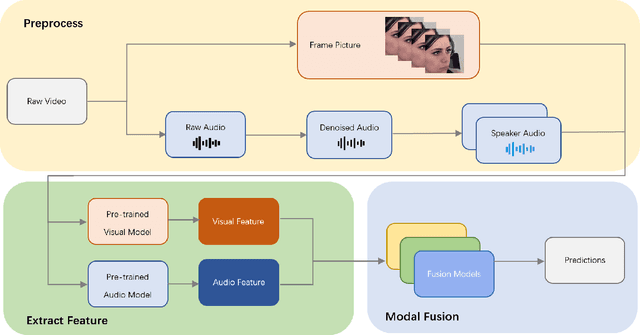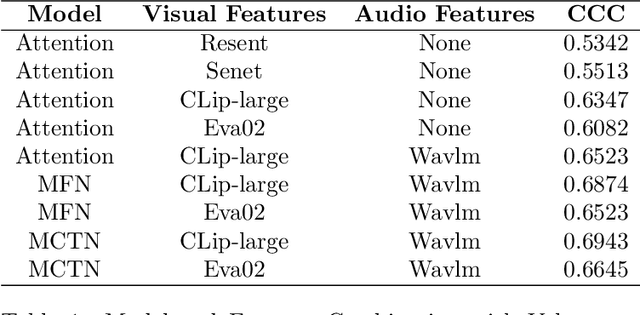Siyuan Zhang
REOBench: Benchmarking Robustness of Earth Observation Foundation Models
May 22, 2025Abstract:Earth observation foundation models have shown strong generalization across multiple Earth observation tasks, but their robustness under real-world perturbations remains underexplored. To bridge this gap, we introduce REOBench, the first comprehensive benchmark for evaluating the robustness of Earth observation foundation models across six tasks and twelve types of image corruptions, including both appearance-based and geometric perturbations. To ensure realistic and fine-grained evaluation, our benchmark focuses on high-resolution optical remote sensing images, which are widely used in critical applications such as urban planning and disaster response. We conduct a systematic evaluation of a broad range of models trained using masked image modeling, contrastive learning, and vision-language pre-training paradigms. Our results reveal that (1) existing Earth observation foundation models experience significant performance degradation when exposed to input corruptions. (2) The severity of degradation varies across tasks, model architectures, backbone sizes, and types of corruption, with performance drop varying from less than 1% to over 20%. (3) Vision-language models show enhanced robustness, particularly in multimodal tasks. REOBench underscores the vulnerability of current Earth observation foundation models to real-world corruptions and provides actionable insights for developing more robust and reliable models.
From Structural Design to Dynamics Modeling: Control-Oriented Development of a 3-RRR Parallel Ankle Rehabilitation Robot
May 19, 2025Abstract:This paper presents the development of a wearable ankle rehabilitation robot based on a 3-RRR spherical parallel mechanism (SPM) to support multi-DOF recovery through pitch, roll, and yaw motions. The system features a compact, ergonomic structure designed for comfort, safety, and compatibility with ankle biomechanics. A complete design-to-dynamics pipeline has been implemented, including structural design, kinematic modeling for motion planning, and Lagrangian-based dynamic modeling for torque estimation and simulation analysis. Preliminary simulations verify stable joint coordination and smooth motion tracking under representative rehabilitation trajectories. The control framework is currently being developed to enhance responsiveness across the workspace. Future work will focus on integrating personalized modeling and adaptive strategies to address kinematic singularities through model based control. This work establishes a foundational platform for intelligent, personalized ankle rehabilitation, enabling both static training and potential extension to gait-phase-timed assistance.
Log Optimization Simplification Method for Predicting Remaining Time
Mar 10, 2025Abstract:Information systems generate a large volume of event log data during business operations, much of which consists of low-value and redundant information. When performance predictions are made directly from these logs, the accuracy of the predictions can be compromised. Researchers have explored methods to simplify and compress these data while preserving their valuable components. Most existing approaches focus on reducing the dimensionality of the data by eliminating redundant and irrelevant features. However, there has been limited investigation into the efficiency of execution both before and after event log simplification. In this paper, we present a prediction point selection algorithm designed to avoid the simplification of all points that function similarly. We select sequences or self-loop structures to form a simplifiable segment, and we optimize the deviation between the actual simplifiable value and the original data prediction value to prevent over-simplification. Experiments indicate that the simplified event log retains its predictive performance and, in some cases, enhances its predictive accuracy compared to the original event log.
Self-Memory Alignment: Mitigating Factual Hallucinations with Generalized Improvement
Feb 26, 2025Abstract:Large Language Models (LLMs) often struggle to align their responses with objective facts, resulting in the issue of factual hallucinations, which can be difficult to detect and mislead users without relevant knowledge. While post-training techniques have been employed to mitigate the issue, existing methods usually suffer from poor generalization and trade-offs in different capabilities. In this paper, we propose to address it by directly augmenting LLM's fundamental ability to precisely leverage its existing memory--the knowledge acquired from pre-training data. We introduce self-memory alignment (SMA), which fine-tunes the model on self-generated responses to precise and simple factual questions through preference optimization. Furthermore, we construct FactualBench, a comprehensive and precise factual QA dataset containing 181k Chinese data spanning 21 domains, to facilitate both evaluation and training. Extensive experiments show that SMA significantly improves LLMs' overall performance, with consistent enhancement across various benchmarks concerning factuality, as well as helpfulness and comprehensive skills.
STAIR: Improving Safety Alignment with Introspective Reasoning
Feb 04, 2025



Abstract:Ensuring the safety and harmlessness of Large Language Models (LLMs) has become equally critical as their performance in applications. However, existing safety alignment methods typically suffer from safety-performance trade-offs and the susceptibility to jailbreak attacks, primarily due to their reliance on direct refusals for malicious queries. In this paper, we propose STAIR, a novel framework that integrates SafeTy Alignment with Itrospective Reasoning. We enable LLMs to identify safety risks through step-by-step analysis by self-improving chain-of-thought (CoT) reasoning with safety awareness. STAIR first equips the model with a structured reasoning capability and then advances safety alignment via iterative preference optimization on step-level reasoning data generated using our newly proposed Safety-Informed Monte Carlo Tree Search (SI-MCTS). We further train a process reward model on this data to guide test-time searches for improved responses. Extensive experiments show that STAIR effectively mitigates harmful outputs while better preserving helpfulness, compared to instinctive alignment strategies. With test-time scaling, STAIR achieves a safety performance comparable to Claude-3.5 against popular jailbreak attacks. Relevant resources in this work are available at https://github.com/thu-ml/STAIR.
Parametric $ρ$-Norm Scaling Calibration
Dec 19, 2024Abstract:Output uncertainty indicates whether the probabilistic properties reflect objective characteristics of the model output. Unlike most loss functions and metrics in machine learning, uncertainty pertains to individual samples, but validating it on individual samples is unfeasible. When validated collectively, it cannot fully represent individual sample properties, posing a challenge in calibrating model confidence in a limited data set. Hence, it is crucial to consider confidence calibration characteristics. To counter the adverse effects of the gradual amplification of the classifier output amplitude in supervised learning, we introduce a post-processing parametric calibration method, $\rho$-Norm Scaling, which expands the calibrator expression and mitigates overconfidence due to excessive amplitude while preserving accuracy. Moreover, bin-level objective-based calibrator optimization often results in the loss of significant instance-level information. Therefore, we include probability distribution regularization, which incorporates specific priori information that the instance-level uncertainty distribution after calibration should resemble the distribution before calibration. Experimental results demonstrate the substantial enhancement in the post-processing calibrator for uncertainty calibration with our proposed method.
MER 2024: Semi-Supervised Learning, Noise Robustness, and Open-Vocabulary Multimodal Emotion Recognition
Apr 29, 2024



Abstract:Multimodal emotion recognition is an important research topic in artificial intelligence. Over the past few decades, researchers have made remarkable progress by increasing dataset size and building more effective architectures. However, due to various reasons (such as complex environments and inaccurate labels), current systems still cannot meet the demands of practical applications. Therefore, we plan to organize a series of challenges around emotion recognition to further promote the development of this field. Last year, we launched MER2023, focusing on three topics: multi-label learning, noise robustness, and semi-supervised learning. This year, we continue to organize MER2024. In addition to expanding the dataset size, we introduce a new track around open-vocabulary emotion recognition. The main consideration for this track is that existing datasets often fix the label space and use majority voting to enhance annotator consistency, but this process may limit the model's ability to describe subtle emotions. In this track, we encourage participants to generate any number of labels in any category, aiming to describe the emotional state as accurately as possible. Our baseline is based on MERTools and the code is available at: https://github.com/zeroQiaoba/MERTools/tree/master/MER2024.
Exploring the Transferability of Visual Prompting for Multimodal Large Language Models
Apr 17, 2024



Abstract:Although Multimodal Large Language Models (MLLMs) have demonstrated promising versatile capabilities, their performance is still inferior to specialized models on downstream tasks, which makes adaptation necessary to enhance their utility. However, fine-tuning methods require independent training for every model, leading to huge computation and memory overheads. In this paper, we propose a novel setting where we aim to improve the performance of diverse MLLMs with a group of shared parameters optimized for a downstream task. To achieve this, we propose Transferable Visual Prompting (TVP), a simple and effective approach to generate visual prompts that can transfer to different models and improve their performance on downstream tasks after trained on only one model. We introduce two strategies to address the issue of cross-model feature corruption of existing visual prompting methods and enhance the transferability of the learned prompts, including 1) Feature Consistency Alignment: which imposes constraints to the prompted feature changes to maintain task-agnostic knowledge; 2) Task Semantics Enrichment: which encourages the prompted images to contain richer task-specific semantics with language guidance. We validate the effectiveness of TVP through extensive experiments with 6 modern MLLMs on a wide variety of tasks ranging from object recognition and counting to multimodal reasoning and hallucination correction.
Multimodal Fusion with Pre-Trained Model Features in Affective Behaviour Analysis In-the-wild
Mar 22, 2024


Abstract:Multimodal fusion is a significant method for most multimodal tasks. With the recent surge in the number of large pre-trained models, combining both multimodal fusion methods and pre-trained model features can achieve outstanding performance in many multimodal tasks. In this paper, we present our approach, which leverages both advantages for addressing the task of Expression (Expr) Recognition and Valence-Arousal (VA) Estimation. We evaluate the Aff-Wild2 database using pre-trained models, then extract the final hidden layers of the models as features. Following preprocessing and interpolation or convolution to align the extracted features, different models are employed for modal fusion. Our code is available at GitHub - FulgenceWen/ABAW6th.
Decentralized Stochastic Subgradient Methods for Nonsmooth Nonconvex Optimization
Mar 18, 2024Abstract:In this paper, we concentrate on decentralized optimization problems with nonconvex and nonsmooth objective functions, especially on the decentralized training of nonsmooth neural networks. We introduce a unified framework, named DSM, to analyze the global convergence of decentralized stochastic subgradient methods. We prove the global convergence of our proposed framework under mild conditions, by establishing that the generated sequence asymptotically approximates the trajectories of its associated differential inclusion. Furthermore, we establish that our proposed framework encompasses a wide range of existing efficient decentralized subgradient methods, including decentralized stochastic subgradient descent (DSGD), DSGD with gradient-tracking technique (DSGD-T), and DSGD with momentum (DSGDm). In addition, we introduce SignSGD employing the sign map to regularize the update directions in DSGDm, and show it is enclosed in our proposed framework. Consequently, our convergence results establish, for the first time, global convergence of these methods when applied to nonsmooth nonconvex objectives. Preliminary numerical experiments demonstrate that our proposed framework yields highly efficient decentralized subgradient methods with convergence guarantees in the training of nonsmooth neural networks.
 Add to Chrome
Add to Chrome Add to Firefox
Add to Firefox Add to Edge
Add to Edge